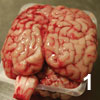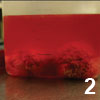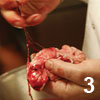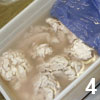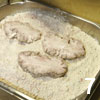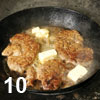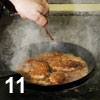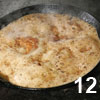Use your brains
Calves' and sheep's brains have almost dropped out of the repertoire of edible offal. The obvious reason is that during the BSE epidemic they had to be removed from beef carcasses. Underlying this then-necessary precaution was another more practical one: very few English people had ever eaten them, so nobody complained. Why should the foodie pundits start a "Bring back brains" campaign when only a handful have tried them?
In France, brains have never slipped from favour as part of the day-to-day cuisine. They haven't often figured in three-Michelin-starred restaurants, because their natural place is either in the home, the bistro or the bouchon. Parents feed them to infants. Le patron puts them on his plat du jour. They are generally enjoyed because there's a consensus about how to cook them and how they should taste.
Not knowing how to cook something is a passable professional excuse for not attempting it. Most modern-British chefs who haven't tried cooking brains are off the hook, because they've never learnt how. Henry Harris, at Racine, could suggest plausible reasons why they steer clear. Raw brains have a lingering smell, unlike meat, for which they may feel an instinctive repulsion. Calves' brains, in particular, are hard to source - he imports his from Paris's Rungis market. They're perishable and risk being wasted unless handled properly. If they aren't cooked according to the rule book, the classic way, they can be downright unpleasant to eat.
That said, they deserve a place on any gastropub, brasserie or bistro menu. On the plate they bear no relation to their Hannibal Lecter image. The texture and the taste is as accessible as sweetbreads, less pronounced than either kidneys or liver. The cutting-edge cooks who are fishing around for new ingredients, experimenting with swim bladders and tuna tripe, have been missing a trick. They should use their brains.
Henry Harris At his London restaurant in Knightsbridge, Racine, Henry Harris does the kind of French bistro cooking that anyone would be happy to find in Lyons or Paris. Because his style is an honest homage to cuisine bourgeoise, it may even be better. He doesn't feel the need to tinker with classics that work. Rather, he insists on cutting no corners, taking care of small but important details and ensuring that nothing leaves his kitchen that he wouldn't happily eat himself.
This personal style, loyal to its roots, derives from his personal taste, but also his training. His father owned a French restaurant in Brighton: Le Grandgousier. He worked for the late Karl Loederer, of Manley's in Storrington, Sussex, who instilled in him both the rigour necessary to produce classic cooking as well as a respect for the traditions underpinning it. Years spent working alongside Simon Hopkinson at Bibendum completed his education, before he went on to open the Fifth Floor at Harvey Nichols. The Fifth Floor Cook Book (1998, Fourth Dimension), which he wrote while there, is one of the few chef's books from which it is possible to cook without fear of mishaps.
Calves' brains
(Lambs' brains are prepared in the same way)
Cost: About £2.50 per set
Yield: at Racine One set of brains per main-course portion or two starters. Also, a slice of brain is served with the calf's head main course. One set serves four.
Basic anatomy
Each set has two matching halves with bumps that make it look a little like a walnut (1).
At the base is a smaller, less regular-shaped area. The brain is covered with a transparent membrane. The word "lobe" is often misapplied to the two halves - each half is made up of four lobes.
Sets of calves' brains, depending on their age, weigh about 500g raw. Veal isn't hung like beef, so brains should be as fresh as possible, processed within days of slaughter.
On delivery, check the surface. Ideally, any blood on it will look bright - think of a parallel with fresh fish. Racine takes delivery of 12 sets of brains at a time and batch-prepares them together.
Soaking
Immerse the brains in chilled, salted water (2) (roughly 12g of salt per litre) for at least one hour.
They should be completely covered. Drain them. Pat each set dry with a clean cloth or absorbent paper.
Removing the membrane
Pull off the membrane covering the brain (3) along with any blood spots.
Do this over a bowl of water, because the fingers can get tacky and the membrane is harder to remove when dry. Occasionally it will come away in a single piece, but more often this is a fiddly job that can take about 15 minutes. Take the time necessary, but don't damage the brain itself. Keep it in a single piece.
Precooking
It's critical from both an eating and a storage point of view that the brain be cooked thoroughly at this stage.
Immerse the brains in a large pan of cold, fresh water. Add about 10g salt and 2tbs basic white wine vinegar per litre. Bring to the boil, skim and simmer gently for 20 minutes.
Storage
Transfer the brains to a storage container, ensuring that each set remains intact (4).
Pour over their cooking liquor. Cover with a double layer of absorbent paper or Tupperware-style lid and chill down as close to freezing point as your refrigeration allows.
Beurre noisette - hazelnut butter
This was once a basic technique taught to all apprentice cooks. It's not burnt butter, but a speckled brownish colour that comes from frying food coated in flour, à la meunière - "in the style of the miller's wife".
Fried calf's brain with capers and beurre noisette
Advance preparation
Seasoned flour (for about eight main-course servings) Spread 500g flour on a shallow tray. Add 1tbs piment d'espelette or well-flavoured paprika (5), 1 heaped tablespoon Maldon salt, and freshly ground pepper.
Check that the seasoning is evenly distributed.
Chopped broad-leaf parsley Allow about 2tbs per portion. When chopping parsley for this recipe, cut it small, but not to a powder. In some French homes cooks put it in a glass and snip it with scissors.
Clarified butter Kitchens now find it more convenient to keep this in a squeezy bottle. Melt fresh butter and bring it to the boil. Skim off the scum. Take it off the heat and let the solids settle at the bottom of the pan. Pour the warm butterfat into the bottle through a funnel and keep above setting point during service.
Ingredients
(Makes one generous portion)
1 set of cooked brains
Seasoned flour
25g (approx) clarified butter
25g unsalted butter, cubed and chilled
1 level dsp brined capers
1-2tbs mild wine vinegar
2tbs chopped parsley
Note There's no need for extra salt or pepper
Method
Take the brains out of the cooking liquor in which they've been chilled. Pat dry with kitchen paper. Slice through the middle of the two halves. Slice each half front-to-back in half so you have four thick "escalopes" (6) and an irregular-shaped bit.
Coat these in the seasoned flour (7). Do this quite liberally so the flour penetrates the fissures.
Shake off any excess, but don't be afraid of a little flour going into the pan. It will improve the appearance of the beurre noisette.
Heat the clarified butter (8) in a frying pan that's a little larger than the surface area of the brains. Lay the brains, crinkly side down, in the butter (9). They should sizzle on contact.
The aim in frying them is to develop a pleasant brown crust. Don't keep turning the brains in the pan. Let them cook on one side without burning for about five or six minutes. Turn them over and finish cooking.
The correct texture is an almost brittle surface and a curd with some body to it.
Add the cubed butter and shake the pan to melt it quickly (10). Let the solids in it begin to change colour. Add the capers and let them cook for a few more seconds. Splash some vinegar around the pan (11). Try to avoid pouring it directly on to the brains.
The pan now will look frothy (what Harris calls "grubby") (12). Sprinkle the foaming brains and the butter on to a hot plate.
When the mousse dies down, the brains should look browned and the hot butter around it shiny.
To serve
Brains are not something that should be served tepid, as has been the fashion with some offal. They should be piping hot. They will keep for a few minutes under the lamp on the pass, but are best if they go from pan to plate to customer's table without delay.
This dish has a very long tradition behind it. It's very rich. Accompany with plain boiled potatoes and perhaps a simple green salad with vinaigrette.
Wine accompaniment Full-bodied white, such as Viognier, or a red Beaujolais cru.
Tete de veau ravigote
Racine also uses brains in another classic French bourgeois recipe: calf's head with a ravigote sauce. The boned and rolled head is simmered in a light, white broth for six hours until it has the classic melting texture. It's then sliced, and a thickish slice of calf's brain, reheated in its own cooking liquid (not fried), is placed on top. The dish is served with shallot rings, potato and a ravigote sauce that is also sometimes served as an accompaniment to fried brains.
For the ravigote sauce
Blend 120ml oil, 1dsp or more strong Dijon mustard and 40ml vinegar to form a stable emulsion. Add chopped parsley, capers, fresh tarragon and 2tbs of very finely diced shallots to taste.



